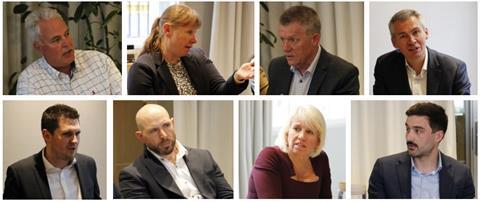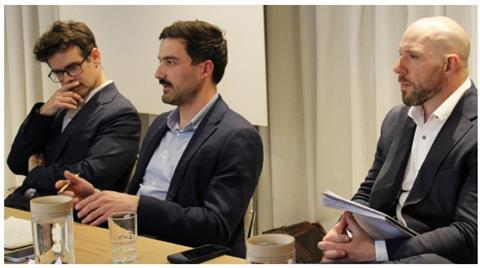A roundtable hosted by �ڶ�����, in partnership with utilities infrastructure provider JSM Group Services, looked at the challenges and potential solutions in providing adequate energy connections for the UK’s data centres – now recognised as critical national infrastructure

With data centres now formally recognised as critical national infrastructure, a spotlight has been cast on whether the UK’s planning and grid systems are keeping pace with their increasing energy needs.
A recent roundtable hosted by �ڶ����� and JSM Group Services brought together representatives from the energy sector, planning, digital infrastructure, legal and investment communities to discuss this pressing issue.
The conversation, chaired by �ڶ�����’s technical editor Thomas Lane, revealed a system under pressure: with speculative projects clogging up the grid, and an outdated planning and connections process that is unresponsive and out of sync with how the data economy operates.
Yet there are reasons for optimism. Grid reform is under way, innovations in flexible connections are taking hold, and there is growing industry collaboration aimed at clearing bottlenecks. But can these changes happen quickly enough?
Grid strain versus actual usage
While the pipeline of connection requests continues to grow, real demand from data centre developers is often far lower. This disparity is fuelling concerns over speculative behaviour and capacity hoarding.
Several panel members noted that while developers might apply for hundreds of megawatts of capacity, actual usage will often be less than half that. This over-application not only blocks viable schemes but also skews planning assumptions. In response, network operators and regulators are calling for more accurate forecasting and better-defined applications from day one.

Some suggested that the UK could learn from international examples. In the US, for instance, developers are often required to submit detailed composite models of expected load behaviour as part of their initial application. These models help transmission owners assess whether requests are credible and deliverable.
Other panellists pointed to system resilience benchmarks abroad. An example highlighted by Brian Moorhead, grid consultancy director at eSmart Networks, was how in Ireland planners often work to an N-1 standard – meaning the capability of maintaining normal operations in the face of a single contingency event. This approach allows more efficient use of the grid while maintaining reliability. He added: “They do a lot more with a lot less network.”
Rob Bath, director of Found Digital DS, also pointed out that lessons could be drawn from the US, where developers must provide clearer upfront load models before applying for capacity.
Tackling zombie projects and speculation
One of the roundtable’s most pointed discussions focused on speculative applications – “zombie projects” – which secure grid space with little intention or ability to build.
Participants acknowledged that reforms are starting to flush these projects out of the system. The introduction of batching and gated windows, where all applications are assessed together, is allowing transmission operators to prioritise real schemes. “A full engineered plan across the whole queue can now be developed – that’s a big change,” said Neil Madgwick, head of service delivery at UKPN.
However, questions remain about the criteria used to define a “credible” project. Land ownership has traditionally been one common marker of credibility, but this was contested during the discussion.

Several attendees noted that developers often will not purchase land without first knowing they have grid access. Others said too many applications come from landowners or intermediaries with no intention of building.
On this point Stephen Bradley, new business director at JSM, was particularly emphatic, saying: “What we’re seeing is that often [it’s] the land developers themselves that are going forward with the applications; it’s not necessarily the data centre developers. That happens after the event that the land developer gets the grid capacity, if ever, and that ties up capacity.”
Similarly, Matt Chatfield, head of electricity network demand strategy at the Department for Energy Security and Net Zero, agreed that it is often non-strategic requests for capacity by Farmer John type landowners, looking to maximise the value of their land, that are taking up capacity in areas data centres will never be developed.
To take this further, Dame Dawn Childs, chief executive of Pure Data Centres, Clive Steed, managing partner at Utility Results, and Stewart Laing, chief executive at Asanti Data Centres, expressed particular keenness to see a more nuanced qualification process for defining a project as speculative. This idea was widely accepted by the group at large.
Around the table
- Chair: Thomas Lane, group technical editor, �ڶ�����
- Rob Bath, director, Found Digital DS
- Daniel Bentham, senior vice-president for energy in EMEA, Vantage
- David Boyer, director for electricity systems, ENA
- Stephen Bradley, new business director, JSM Group
- Matt Chatfield, head of electricity network demand strategy, Department for Energy Security and Net Zero
- Dame Dawn Childs, chief executive, Pure Data Centres
- Martyn Crocker, head of business development, JSM Group
- Charles Deacon, managing director, Eclipse Power Solutions
- Roberta Downey, head of the international construction group, Vinson & Elkins
- Stewart Laing, chief executive, Asanti Data Centres
- Neil Madgwick, head of service delivery, UKPN
- Brian Moorhead, grid consultancy director, eSmart Networks
- Susana Neeves, head of connections strategy and reform, NGED
- Clive Steed, managing partner, Utility Results
- Scarlett Vincent, policy adviser, Department for Energy Security and Net Zero
- Rees Westley, partner, RLB
Planning and system design lagging behind
The panel agreed that the planning system and technical standards such as the Security and Quality of Supply Standard (SQSS) have not kept pace with market needs. Many developers still work with old assumptions about load profiles and capacity limits, despite the arrival of variable, hyperscale and AI-related demand.

System resilience planning also came under scrutiny. Some suggested that operators could accept N-1 resilience standards rather than the more rigid N-2 (which ensures capability in the face of two contingency events), particularly where on-site back-up is already provided. Yet conversations with system planners remain challenging, with participants citing lack of access and misalignment between distribution and transmission operators.
Moorhead said: “It’s very, very difficult to get through the right channels that will cover a project. People might think it should be simple if the grid system planner has done the connection analysis, but trying to get talking to the right people, and get them to the other side of the table from [within the official planning athorities] is difficult. And for some that can just be because they can be under the weight of lots of speculative projects.”
There was a call for more upfront engagement. If developers and system planners had earlier conversations about flexibility, load expectations and ramping profiles, many later conflicts could be avoided. Yet current processes often discourage such dialogue.
Flexible solutions and smarter modelling
If grid connection is the bottleneck, could smarter, more flexible approaches help? Many participants thought so. There was widespread support for introducing flexible and interruptible connections, where loads can be modulated based on network stress. This model is already used in several other countries.
Charles Deacon, managing director of Eclipse Power Solutions said: “Whether there are flexible products or flexible connections – there is loads that can be moved around. The up-front work, to establish exactly what the ask is, is important to work out how flexible we can be.”
Others advocated for ramping profiles that reflect how data centres are actually built out over time, rather than assuming full capacity from day one. This would allow more efficient use of the grid and reduce the number of unfeasible offers being made.
The need to modernise modelling approaches was also stressed. System planners often assume maximum capacity 100% of the time, which does not reflect real-world usage. Reforming how capacity is allocated and modelled could unlock access for many viable projects now stuck in the queue.

Battery storage was highlighted as a major opportunity as the drive for their development fades. As these projects are released or reclassified, they could open up grid space for new demand.
Susana Neeves, head of connections strategy and reform at NGED, pointed out that while battery storage reclassification is key, it is not the full solution.
She said: “The release of battery storage will happen in the background. As we lose those batteries we will be able to bring the network demand [of the] storage back into potential use. It is 26GW that could be up for grabs – but based on the strategic alignment, this will not make up the shortfall.”
Location mismatches and regional inequality
The panel also highlighted stark regional mismatches between demand and capacity. While London and Slough remain hubs for hyperscalers, they are also the most constrained in terms of available power. Meanwhile, grid capacity exists in areas with little market demand.
Childs said: “There needs to be more allure to build a data centre zone elsewhere – you’d be able to get access to cheaper power and land in other geographies. Particularly from a hyperscaler perspective. The barrier is different for regions, but we need to look at how to overcome them.”
This misalignment is driving projects into inefficient locations or leading to planning rejections. Some argued that clearer spatial planning, including designated zones for data centre growth, could provide a more strategic basis for investment.
Several panellists suggested the UK risks falling behind in the global competition for data centre investment. With countries such as Ireland and the Nordics offering more agile connections and planning regimes, the UK must act quickly to maintain its competitive edge.

Daniel Bentham, senior vice-president for energy in EMEA at Vantage, said: “It offers an opportunity for inbound investment into the UK at a time where we need it. And there is a window of time where that is available and there will be a window where it passes us by. What are we doing to capture it?”
A narrow window: speed is now critical
Despite frustrations, the mood was not pessimistic. Many acknowledged the positive direction of current reforms, particularly on queue management and improved modelling. But the overriding message was one of urgency.
Investment is mobile, and if grid access or planning delays push developers to look elsewhere, those opportunities may not return. Several participants noted that windows for international investment are narrow and closing fast. The UK has the talent, demand and capital to lead, but must now match this with delivery.
Some participants cautioned that hyperscalers are shifting focus from carbon purity to delivery timelines. As a result, off-grid solutions – including the use of green hydrogen and waste heat – are gaining traction, despite concerns about sustainability trade-offs.
In short, the sector is at an inflection point. Whether reforms come quickly enough to turn recognition of data centres as critical infrastructure into action remains to be seen.






















